I know I said I’d write another post about Mapping Petersburg, but I’m still thinking about that, so in the mean time, another top ten. But this time it is not the works, but the writers themselves, and specifically their facial adornments, that interest me. Beards, as Elif Batuman has affirmed, are hugely important to Russian culture — why else would Peter the Great have banned them? — and to the image of Russia, as this brilliant map shows:
(Thanks to Peacay for making this available under a creative commons licence; see Satirical Maps of the First World War for some more of the same).
The resurgence of beards in the mid-nineteenth century means I have an abundance of choice, but also gives me the incentive to avoid some of the usual suspects. The rules: they have to be literary figures (so, for instance, Kropotkin is excluded, despite his rather fine specimen), and I have to know something about them — they can’t be writers I’ve just found by googling (although this annoying excludes Nikolai Karazin, who otherwise would have been right up there). Variety and originality of styling are important — this is not just an index of bushiness.
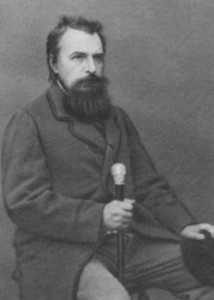 10. Apollon Grigor’ev (1822-1864). I’ve been reading in the last few days about Grigor’ev’s contribution to the Pochvennichestvo movement (native soil conservatism) and his association with Dostoevsky and his brother Mikhail on the journal Time in the early 1860s, but Grigor’ev was also a significant poet and translator. His is not the biggest beard in Russian literary history, but it is a rather decent brush, and is all the more impressive when considered in the context of his extremely disorderly life, which ended prematurely, from alcohol abuse (he was buried in Petersburg’s Mitrofanevskoe cemetery, and it’s crossed my mind that Dostoevsky may in part have based the figure of the drunk Marmeladov on Grigor’ev — no beard is mentioned, but he is buried in the same place).
10. Apollon Grigor’ev (1822-1864). I’ve been reading in the last few days about Grigor’ev’s contribution to the Pochvennichestvo movement (native soil conservatism) and his association with Dostoevsky and his brother Mikhail on the journal Time in the early 1860s, but Grigor’ev was also a significant poet and translator. His is not the biggest beard in Russian literary history, but it is a rather decent brush, and is all the more impressive when considered in the context of his extremely disorderly life, which ended prematurely, from alcohol abuse (he was buried in Petersburg’s Mitrofanevskoe cemetery, and it’s crossed my mind that Dostoevsky may in part have based the figure of the drunk Marmeladov on Grigor’ev — no beard is mentioned, but he is buried in the same place).
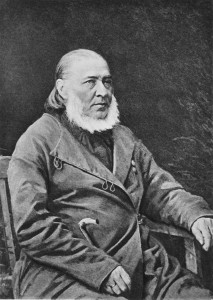 9. Sergei Aksakov (1791-1859). The Slavophiles generally had surprisingly weedy (and in some cases Western-looking) beards, but Sergei Aksakov, the father of one of the most prominent early Slavophiles, Konstantin, certainly did Russia proud on the facial hair front. The beard-without-moustache look is difficult to pull off — often it merely serves to make a long face seem longer, as in the case of Dobroliubov — but Aksakov does it with style. He was also a far more interesting writer than his sons. For some reason I always assumed that his Family Chronicle (also translated as A Russian Gentleman) would be rather dull, the sort of thing that one was obliged to read for background but would always be a duty rather than a pleasure, so I put it off for as long as possible (a rather bad habit I have). And it was a real mistake, as when I finally got round to it, I discovered what a rich, lively book it is, the best possible description of the life of the Russian nobility and a country estate.
9. Sergei Aksakov (1791-1859). The Slavophiles generally had surprisingly weedy (and in some cases Western-looking) beards, but Sergei Aksakov, the father of one of the most prominent early Slavophiles, Konstantin, certainly did Russia proud on the facial hair front. The beard-without-moustache look is difficult to pull off — often it merely serves to make a long face seem longer, as in the case of Dobroliubov — but Aksakov does it with style. He was also a far more interesting writer than his sons. For some reason I always assumed that his Family Chronicle (also translated as A Russian Gentleman) would be rather dull, the sort of thing that one was obliged to read for background but would always be a duty rather than a pleasure, so I put it off for as long as possible (a rather bad habit I have). And it was a real mistake, as when I finally got round to it, I discovered what a rich, lively book it is, the best possible description of the life of the Russian nobility and a country estate.
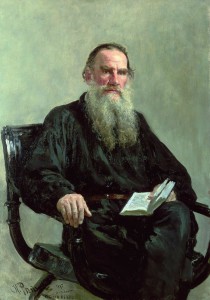 8. Lev Tolstoy (1828-1910). If there’s one area in which even I have to admit that Tolstoy beats Dostoevsky, it’s his beard. Dostoevsky’s was a rather scrawny affair (you will note he hasn’t made it onto this list — just to show I’m not biased — although you may also spot that most of this entry on Tolstoy is actually about Dostoevsky), whereas Tolstoy seems to have maintained a healthy bushiness right to the end. No need to say anything about his works.
8. Lev Tolstoy (1828-1910). If there’s one area in which even I have to admit that Tolstoy beats Dostoevsky, it’s his beard. Dostoevsky’s was a rather scrawny affair (you will note he hasn’t made it onto this list — just to show I’m not biased — although you may also spot that most of this entry on Tolstoy is actually about Dostoevsky), whereas Tolstoy seems to have maintained a healthy bushiness right to the end. No need to say anything about his works.
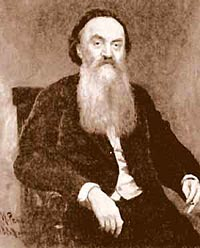 7. Nikolai Strakhov (1828-1896). I don’t think I’d ever seen a picture of Strakhov until the other day, and somehow it was quite unexpected. I suppose I thought he’d look more like the dull old reactionary he was. Anyway, he was an important figure, not only for his collaboration with Dostoevsky and friendship with Tolstoy, and the stupid remarks he made about the former to the latter, but also for his literary criticism and contribution to the philosophy of Pochvennichestvo. And his beard is impressively long and full.
7. Nikolai Strakhov (1828-1896). I don’t think I’d ever seen a picture of Strakhov until the other day, and somehow it was quite unexpected. I suppose I thought he’d look more like the dull old reactionary he was. Anyway, he was an important figure, not only for his collaboration with Dostoevsky and friendship with Tolstoy, and the stupid remarks he made about the former to the latter, but also for his literary criticism and contribution to the philosophy of Pochvennichestvo. And his beard is impressively long and full.
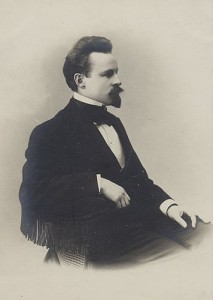 6. Konstantin Balmont (1867-1942). You will have gathered by now that luxuriant beards win out over neatly trimmed jobs, but I felt that one example of the latter should make it onto my list, and Balmont’s was certainly the most stylish. He was also an interesting writer and cultural figure — his translations of Edgar Allan Poe are still renowned, and the musical quality of poetry is apparent in the fact that many of his works were set to music by some of Russia’s most famous composers. I’m not a huge fan of poetry from that period, but I love his 1902 collection Budem kak solntse. Kniga simvolov (Let us be Like the Sun. A Book of Symbols) — one of the few collections of Silver Age poetry I’ve read from beginning to end — as well as some of his more folkloric stuff, especially that with Eastern influences.
6. Konstantin Balmont (1867-1942). You will have gathered by now that luxuriant beards win out over neatly trimmed jobs, but I felt that one example of the latter should make it onto my list, and Balmont’s was certainly the most stylish. He was also an interesting writer and cultural figure — his translations of Edgar Allan Poe are still renowned, and the musical quality of poetry is apparent in the fact that many of his works were set to music by some of Russia’s most famous composers. I’m not a huge fan of poetry from that period, but I love his 1902 collection Budem kak solntse. Kniga simvolov (Let us be Like the Sun. A Book of Symbols) — one of the few collections of Silver Age poetry I’ve read from beginning to end — as well as some of his more folkloric stuff, especially that with Eastern influences.
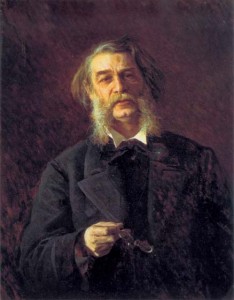 5. Dmitry Grigorovich (1822-1900). Another writer who’s been on my mind a good deal lately, mainly because I’ve been re-reading his first published work, The Petersburg Organ-Grinders and thinking about his connections with Dostoevsky — the two were living together in the mid-1840s, and it was Grigorovich who showed the manuscript of Dostoevsky’s first work, Poor Folk, to Nekrasov. Again, although I’ve known of the famous 1856 photo of contributors to Sovremennik (The Contemporary) for a long time, Grigorovich’s presence in the picture never really registered (it’s usually shown as a picture of Tolstoy and Turgenev), and I’ve only very recently seen separate pictures of him. He wins the competition for best side-whiskers hands down.
5. Dmitry Grigorovich (1822-1900). Another writer who’s been on my mind a good deal lately, mainly because I’ve been re-reading his first published work, The Petersburg Organ-Grinders and thinking about his connections with Dostoevsky — the two were living together in the mid-1840s, and it was Grigorovich who showed the manuscript of Dostoevsky’s first work, Poor Folk, to Nekrasov. Again, although I’ve known of the famous 1856 photo of contributors to Sovremennik (The Contemporary) for a long time, Grigorovich’s presence in the picture never really registered (it’s usually shown as a picture of Tolstoy and Turgenev), and I’ve only very recently seen separate pictures of him. He wins the competition for best side-whiskers hands down.
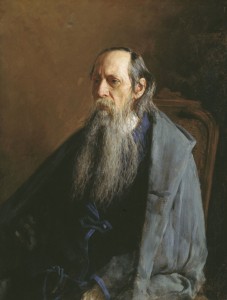 4. Mikhail Saltykov-Shchedrin (1826-1889). I find Saltykov-Shchedrin a slightly odd figure — the combination of service to the Russian government and biting satire doesn’t really go together, though perhaps it was the former that gave him inspiration to write the latter. His works are a bit hit and miss. The History of a Town seems to me very heavy-handed, but I love The Golovev Family (also translated as A Family of Noblemen) — possibly the zenith of unpleasant, gloomy side of Russian literature, but it still manages to be good fun. In the appearance stakes, he simply does the cadaverous-with-straggly-beard look far better than Dostoevsky.
4. Mikhail Saltykov-Shchedrin (1826-1889). I find Saltykov-Shchedrin a slightly odd figure — the combination of service to the Russian government and biting satire doesn’t really go together, though perhaps it was the former that gave him inspiration to write the latter. His works are a bit hit and miss. The History of a Town seems to me very heavy-handed, but I love The Golovev Family (also translated as A Family of Noblemen) — possibly the zenith of unpleasant, gloomy side of Russian literature, but it still manages to be good fun. In the appearance stakes, he simply does the cadaverous-with-straggly-beard look far better than Dostoevsky.
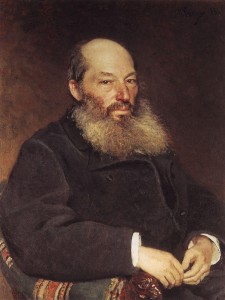 3. Afansy Fet (1820-1892). From one extreme to another. Fet’s beard exudes good health, although that may be a bit misleading, as by all accounts he didn’t have a particularly happy life, and attempted suicide more than once. And I don’t have a particularly good association with him — having to plough through hundreds of lyric poems by Tiutchev and Fet as an undergraduate was what made me realize that even if I enjoy reading it, I don’t have an ear for Russian poetry, which was a rather depressing experience. But I do still have memories of Fet’s poems of tragic love, so it obviously wasn’t a complete waste of time, and those who know more about these things that I do see Fet as being a crucial influence on Silver Age poetry.
3. Afansy Fet (1820-1892). From one extreme to another. Fet’s beard exudes good health, although that may be a bit misleading, as by all accounts he didn’t have a particularly happy life, and attempted suicide more than once. And I don’t have a particularly good association with him — having to plough through hundreds of lyric poems by Tiutchev and Fet as an undergraduate was what made me realize that even if I enjoy reading it, I don’t have an ear for Russian poetry, which was a rather depressing experience. But I do still have memories of Fet’s poems of tragic love, so it obviously wasn’t a complete waste of time, and those who know more about these things that I do see Fet as being a crucial influence on Silver Age poetry.
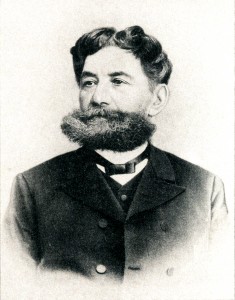
2. Aleksandr Sukhovo-Kobylin (1817-1903). Prior to writing this post, I knew precisely three things about the playwright Sukhovo-Kobylin. His sister, Evgeniia Tur, was rather more famous as a writer than he was. He spent several years on remand in France on the (probably) trumped-up charge of murdering his mistress. And he is mentioned in typically arch fashion by Solzhenitsyn in In the First Circle, when Clara Makarygina is thinking about the university literature course she has abandoned: ‘there had been a quick round-up of a whole load of unknowns like Stepniak-Kravchinsky, Dostoevsky and Sukhovo-Kobylin, the title of whose works there was apparently no need even to learn.’ (vol. 1, ch. 43). I now also know that he had a magnificent, bristly beard.
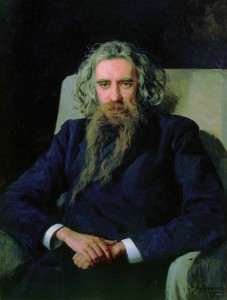 1. Vladimir Solov’ev (1853-1900). The pictures of Solov’ev that are available online are a bit disappointing. The ones I’ve seen in books give a far better impression of his increasingly wild hair and two-pointed beard, treading the fine line between Old Testament prophet and madman with such aplomb that it’s hard to believe there was anything accidental in his appearance. I know Solov’ev’s philosophical works far better than his poetry, but he was equally important in both fields, and I have discovered that although he was more rigorous than most Russian thinkers, his theoretical works (which can seem hard to penetrate, not least because of their mystical and spiritual elements) are best read as though they are poetry.
1. Vladimir Solov’ev (1853-1900). The pictures of Solov’ev that are available online are a bit disappointing. The ones I’ve seen in books give a far better impression of his increasingly wild hair and two-pointed beard, treading the fine line between Old Testament prophet and madman with such aplomb that it’s hard to believe there was anything accidental in his appearance. I know Solov’ev’s philosophical works far better than his poetry, but he was equally important in both fields, and I have discovered that although he was more rigorous than most Russian thinkers, his theoretical works (which can seem hard to penetrate, not least because of their mystical and spiritual elements) are best read as though they are poetry.

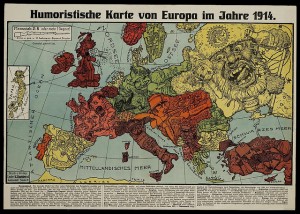
Philip Hines
/ April 26, 2011Very impressed by these. No. 2 actually defies gravity, and the bizarre hairstyle takes the effect to another level. He may have spent more time with the mirror than the pen.
Aksakov’s memoirs are wonderful. I have a 1917 edition of “A Russian Schoolboy” translated by J.D.Duff (much of whose work turned up later as Oxford World Classics) which contains an appendix about butterfly hunting which Nabokov must have known. Some similarities with Turgenev’s Sportsman’s Sketches too.
sir terence chin-tickle
/ June 10, 2011lovely page!
be great if you had a facebook share button ..
thx
Who Even Cares?
/ March 11, 2013It is nothing short of a scandal that Kropotkin is not on this list.
Sarah Young
/ March 11, 2013You will see that my rules specify literary figures. Much as I like Kropotkin’s writings, and admire his beard, I do not think he fits into this category.